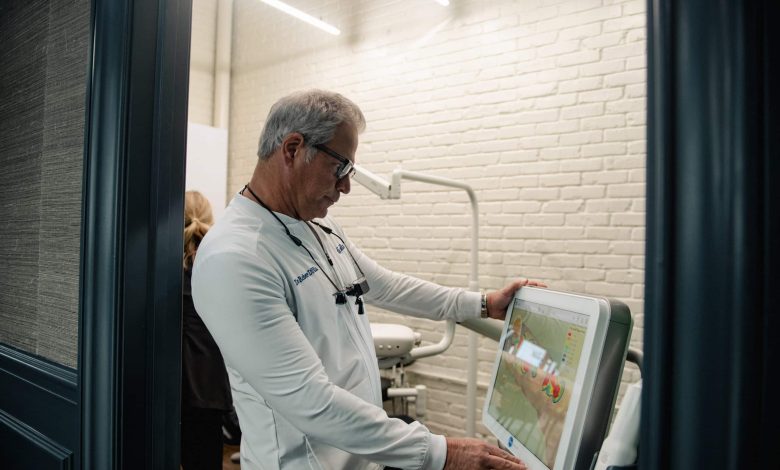
For decades, dentistry has been defined by precision, artistry and a deep understanding of oral health. But even the most skilled dentist could only do so much…until now.
Artificial intelligence (AI) tools are revolutionizing the way dentists diagnose, plan and deliver care, giving patients not only beautiful smiles, but healthier ones, too.
Innovation is key to elevating both patient experience and outcomes. From the beginning, my goal as the founder of DiPilla Dentistry has been to combine the best of advanced science and technology with compassionate care. Today, AI is helping do exactly that from the dentist’s chair, in ways once unimaginable.
Seeing Beyond the Human Eye
Dentistry has long relied on X-rays and radiographs to detect issues beneath the tooth’s surface. However, traditional imaging depends heavily on the practitioner’s interpretation, which can vary greatly from one dentist to another. The human eye can perceive, on average, a few dozen shades of gray, but dental AI software like Pearl, the technology used at DiPilla Dentistry, can recognize hundreds of colors.
It’s like having a high-definition lens on every X-Ray taken, where early signs of trouble can be easily spotted. This includes subtle variations in a tooth’s density, structure or even the beginnings of cavities, microfractures, abscesses and gum disease.
By recognizing and analyzing tiny details, AI can be a powerful second opinion. It’s not about replacing dentists; it’s about enhancing accuracy and preventing misdiagnosis. For example, I once saw a patient who was told by another dentist that she had twelve cavities. Understandably, she was anxious and frustrated. After taking new X-rays and running them through our AI software, the results revealed that only six were of actual concern. The rest were minor enamel changes or early-stage issues that required monitoring, not drilling.
That’s the power of AI: it ensures patients receive the right treatment, at the right time, based on objective data rather than subjective interpretation.
Turning Diagnosis into Prevention
AI isn’t just about identifying existing problems but predicting and preventing them. By detecting early warning signs that are often invisible to the naked eye, AI allows dentists to create more proactive and personalized treatment plans.
When potential issues are caught early, patients can make small, manageable changes like adjusting brushing habits, improving diet or using specific fluoride treatments before they escalate into painful or costly conditions. This turns the dental visit into an educational moment rather than a reactive one.
Preventative care has always been at the heart of dentistry, but AI takes it a step further. The technology helps us look ahead, anticipate problems and intervene before they require major restorative work. Predictive analytics lead to better outcomes, which in turn build trust between the clinician and patient.
Leveling the Playing Field
Another major benefit of AI in dentistry is its ability to standardize diagnostic accuracy. Even the most talented new dentist can struggle to interpret subtle imaging differences that come naturally with years of practice. AI closes that gap.
By confirming or questioning potential diagnoses, AI serves as an objective tool that enhances confidence and consistency. In other words, every dentist, whether fresh out of dental school or with decades of experience, can offer the same diagnostic precision.
When a dentist can show an AI-supported image highlighting areas of concern, patients see exactly what the clinician sees. The transparency creates a shared understanding that strengthens the relationship and increases confidence in the treatment plan.
Enhancing the Patient Experience
While AI’s diagnostic capabilities are often the headline, its impact on the patient experience is just as important. At DiPilla Dentistry, we use AI not only in imaging, but also in how we communicate with and serve our patients.
For instance, our AI-assisted phone system helps streamline scheduling, reminders and follow-up calls, ensuring a seamless and responsive experience. Patients receive quick answers and personalized service — something I like to call concierge-level dentistry.
Let’s be honest: most people look for any excuse not to see the dentist. By integrating AI into every touchpoint, from the first phone call to post-appointment follow-up, we’re making each interaction smoother, faster and more comfortable. This modern approach helps patients feel cared for, valued and understood.
Predictive Analytics and the Future of Care
As AI continues to evolve, we’re entering an era of predictive dentistry. Advanced algorithms can analyze massive amounts of patient data, including X-rays, dental charts and even lifestyle factors to forecast potential risks and personalize care plans.
Imagine being able to predict which patients are most at risk for developing periodontal disease or tooth decay years before symptoms appear. That’s the next frontier – and it’s within reach.
AI also helps streamline clinical workflows, reducing errors and freeing up time for what matters most: patient connection. When dentists spend less time sifting through data and more time engaging with patients, the result is higher-quality care and stronger trust.
A Smarter, More Human Future
Some people worry that AI might make healthcare feel less personal, but in my experience, it does the opposite. By automating routine processes and improving diagnostic accuracy, AI frees dentists to listen, educate,and connect.
AI Technology, like we use at DiPilla Dentistry, doesn’t replace our judgment; it enhances it. It’s the digital equivalent of a colleague offering a second opinion — one that’s unbiased, data-driven and incredibly precise.
At DiPilla Dentistry, our mission has always been to combine artistry, innovation and compassion. AI is simply the latest tool helping us fulfill our promise. By integrating cutting-edge technology with a personalized approach, we’re not just transforming smiles; we’re transforming what it means to experience preventative dental care.



